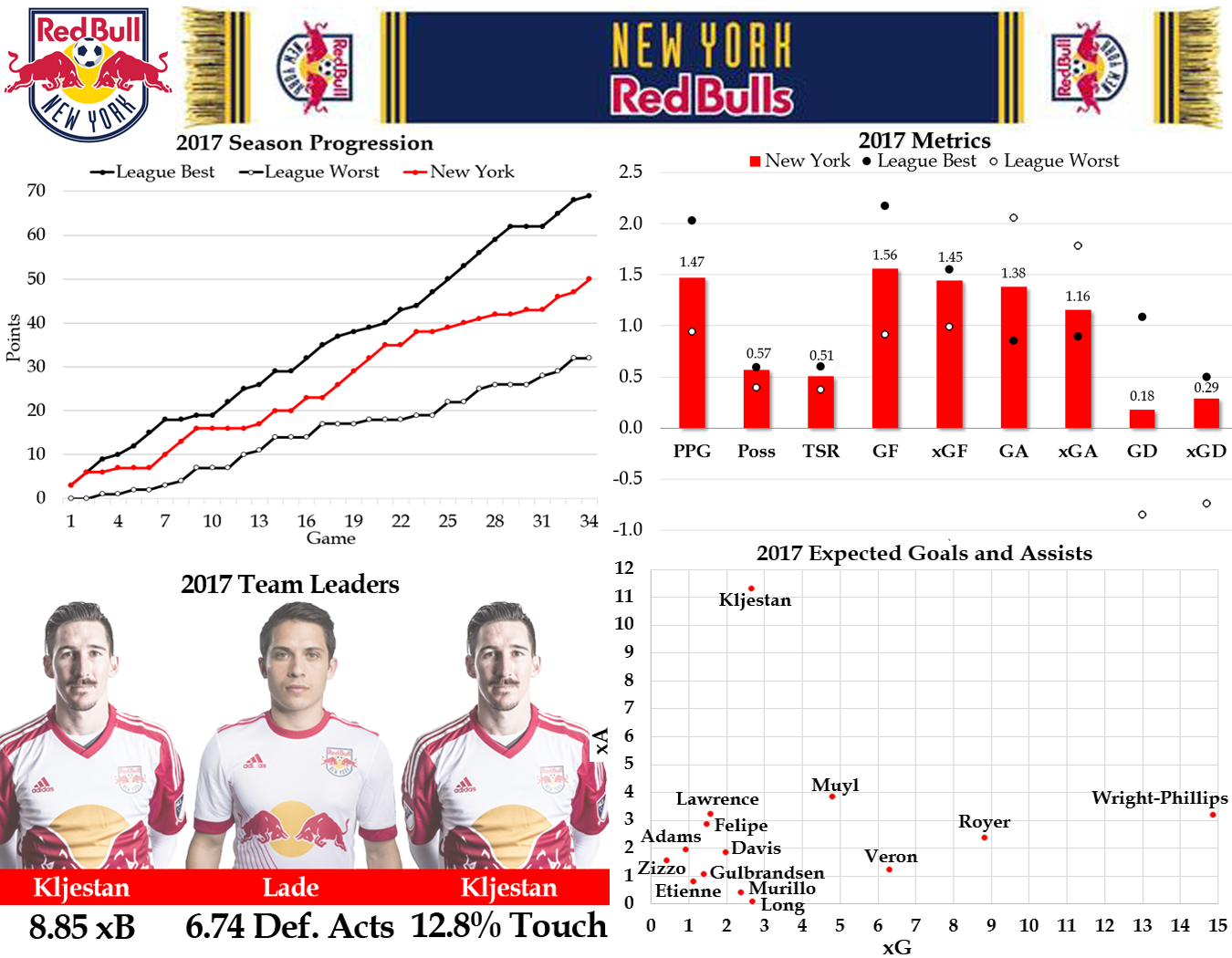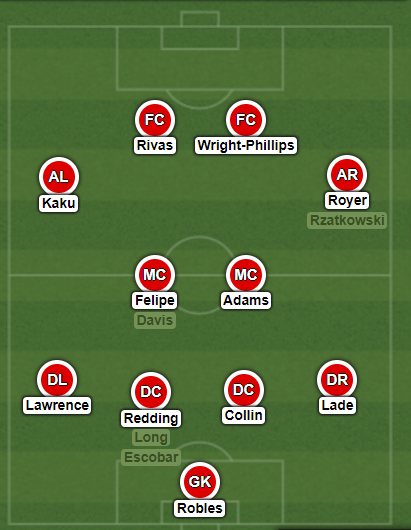New York Red Bulls 2018 Season Preview
/Here's more about Expected Goals (xG) and Expected Assists (xA). Expected Buildup Goal Chain is abbreviated to xB. Defensive Acts are per 96 minutes and are defined as blocks, interceptions, tackles, and challenges. Touch percentage is the player's percentage of all team touches while on the field. Pretty much all the data in the above graphic can be found in our interactive tables. They're pretty cool so you should check them out.
By Benjamin Bellman (@beninquiring)
Whatever your opinions of the New York Red Bulls might be, you can’t accuse them of being boring. For the past three MLS seasons, the Red Bulls have consistently been one of the best attacking teams as measured by xG, ranking first in 2015, fifth in 2016, and third in 2017. But the real drama seems to happen off the field, and this winter was no different. Previously, after the 2016 season, Jesse Marsch pulled a power move over Ali Curtis, the man who controversially booted team legend Mike Petke to hire him, and traded team captain Dax McCarty to the Chicago Fire. Now he’s done it again, trading team captain and MLS assist master Sacha Kljestan to Orlando City. Throw in what was the most confirmed unconfirmed signing in memory, and you've got a recipe for some kind of 2018. Strap in, New York/New Jersey, it’s gonna be a wild one.
2017 IN REVIEW
In some ways, 2017 was slightly disappointing for Red Bulls fans compared to their 2016 success. After claiming first in the East in 2016 with 57 points, the Red Bulls landed in sixth in the East with 50 points without McCarty marshaling the midfield. In the beginning of the season, the trade seemed to cause problems and the Red Bulls lost six of their first 12 games. But the team got hot in the summer, notably winning every game they played in July, and despite going 0-3-5 between August 18 and September 30, they managed to hang onto a playoff berth. And while NYRB dropped some points during the regular season, they showed their true stripes in the postseason. First, they absolutely crushed McCarty’s Fire 4-0 in Chicago, and then they pushed the Greatest MLS Team Ever to the brink, falling to Toronto 2-2 on aggregate based on the away goals rule. While the season was ultimately successful, fans remember the shaky spring, and they will certainly expect more playoffs (and ultimately improvement) if they are to accept that trading Kljestan was the right thing to do.
OFFSEASON CHANGES
There was plenty of other roster turnover happening during the winter as well. Forward Gonzalo Verón had his option declined after two and a half disappointing seasons as a Designated Player, scoring only 10 goals in 60 appearances. Among others, familiar names like Sal Zizzo, Gideon Baah, Mike Grella, Dilly Duka, and Damien Perrinelle will no longer appear on the game day rosters.
Carlos Rivas and Tommy Redding are both arriving from Orlando City in exchange for Kljestan and some Garber Bucks. Rivas is 23 and Redding is 21, so it’s clear that the Red Bulls are keen to get younger players that haven’t reached their true ceiling yet. Bradley Wright-Phillips, top all-time scorer for NYRB, is now 32, so given Marsch’s tendencies this could very well be his last year on the team, making the Rivas acquisition particularly interesting. Apart from the trade, it’s clear that NYRB really prefer to bring in players from their development system. Forward Stefan Bonomo and midfielder Florian Valot were signed from Red Bulls II in USL, defender Kevin Politz and midfielder Ben Mines were signed as homegrown players, and Marc Rzatkowski joins on loan from Red Bull Salzburg. Additionally, 18-year-old Venezuelan Cristian Cásseres Jr. was bought from Deportivo La Guaira, and previous NYRB academy product Amando Moreno re-joins on a free after only making four appearances for Tijuana over three years, and then being loaned to Dorados in the second division league in Mexico. And finally, the transfer of 23-year-old Argentine winger Alejandro “El Kaku” Romero Gamarra from Huracan as a Designated Player is official after two months of rumors. Kaku had joined the team in pre-season well before the official announcement was released, and could very well be ready for CONCACAF Champions League action.
ROSTER EXPECTATIONS
There’s been a lot of talk about the Red Bulls formation, specifically if they’re actually going to emulate the 4-2-2-2/4-2-4 used by RB Leipzig. NYRB have certainly followed a similar philosophy of the high press, and given the shift towards youth and reliance on their own player network, I think it’s very possible it happens permanently this year. This has been the institutional trend for the past few years at Red Bull Arena in Harrison, so while Marsch may not have the confidence to start the year out with a true Leipzig formation right off the bat, I think it’s only a matter of time. Marsch has always shown a willingness to adapt his formations to his available player pool, particularly to the teams glut of central midfielders. This roster turnover seems to be moving away from the old, and ushering in a new synchronized era with the Red Bull family of teams.
Goalkeeper
Proven MLS veteran Luis Robles is in no danger of losing the starting keeper spot, barring injury or a catastrophic decline in form. He holds the record for consecutive starts in MLS, and has the most appearances in club history. Far-less proven MLS veteran Ryan Meara should be the first back-up to Robles, followed by homegrown Evan Louro.
Defense
Another MLS veteran, Aurélien Collin, anchors the center of NYRB’s defense. Unless he gets hurt, Collin will probably be an every-game starter for a defense that is missing some faces from last year. Tommy Redding will probably see a lot of time next to Collin at center back, with Aaron Long and Panamanian Fidel Escobar also getting minutes. Connor Lade has lots of experience for the Red Bulls at right back, and Kemar Lawrence has established a similar record at left back.
Midfield
A key part of NYRB struggles and redemption in 2017 was the new responsibility Marsch gave to a then 18-year-old Tyler Adams. It’s obvious that giving Adams playing time was a big motivator for trading Kljestan, and if his stock rises enough during 2018 it could very well be his last year playing in Harrison. Adams mostly played on the wing in 2017, sensible given Kljestan’s consistent ability to set up scoring opportunities. Looking at the raw and underlying stats in 2017 for both players, Kljestan definitely has the edge with quadruple Adams’s xA per 96 min (0.4 compared to 0.09). But bringing Adams in the central midfield allows for Marsch to change the Red Bulls shape and tactics towards the high press. Adams has some numbers going for him too. He attempted passes with higher chances of success, completing 79.7% in the attacking third compared to 67% for Kljestan. Adams also did a better job converting his scoring opportunities (two goals on 0.93 xG). Of course, all these numbers reflect the positions the two played as much as their skill, so it’s not a sure thing that Adams’s will seamlessly transition into a central role. But he’s played that role during his time in the national team system, and Marsch and Sensei Matt Doyle think that’s where he should be played, so I’m excited to see what he can do when given the keys.
Red Bulls veteran Felipe should be able to provide deep-lying playmaking next to Adams in central midfield, with Sean Davis and Alex Muyl filling in when needed, at least until some of the newer players can out-do them. Beyond Kaku starting wide left, outside midfield is much more of a question mark given that Adams spent a lot of time wide right, and fullback Kemar Lawrence frequently occupied the left wing spot in the lineup. There’s no clear successor to start at right winger. It looks like Rzatkowski mostly played CAM in Salzburg, but he could start the year out wide given his experience. Homegrown Derrick Etienne, Jr. could also spend time wide right, and Royer also spent time there in 2017. Expect Marsch to try a number of options (and different formations entirely) as he continues to instill his tactical dogma into this squad.
Forward
Bradley Wright-Phillips has been one of the most dominant forwards in MLS since he arrived in 2013, tallying 86 goals in 139 regular season appearances. He’s getting older, but it would be silly to expect that to slow. The only concern would be that severing the Kljestan-BWP connection will disrupt his success, but NYRB’s high press is still likely keep opposing defenses on the back foot, generating plenty of scoring opportunities by committee. Marsch will look to develop Rivas into their system, so expect him to get the lion’s share of starts next to BWP in the 4-2-2-2.
2018 PROGNOSIS
Marsch will remember the rocky start to last year and look to avoid it this time around, making me think he won’t start the year with a brand new 4-2-2-2 look. But he should find far more success with that formation in 2018 than last year, and that success will be directly tied to Adams’s ability to command the middle of the field, chasing down players and making cutting passes through a reeling defense. If that really can click, the Red Bulls are capable of pushing the best in the East for the Supporters’ Shield. If there are too many hiccups along the way, playoffs are still likely, but it will be a lower seed, with a similar uphill battle to the 2017 post-season. Whatever happens, this will be a young, fast, and exciting team to watch, and I fully expect them to rack up a lot of big scores in 2018.



